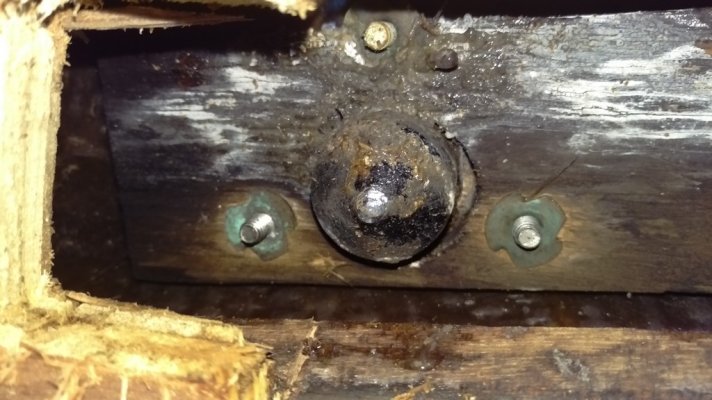sbu22
Guru
- Joined
- Mar 16, 2011
- Messages
- 1,253
- Location
- US
- Vessel Name
- Panache
- Vessel Make
- Viking 43 Double Cabin '76
Chasing deck fitting leaks, I discovered the condition of several original rail stanchion bases as shown. I plan to remove and repair the mess and bring it up to a new rot free deck surface. Even though the old girl is pushing 40, I am extremely disappointed in Viking for the “backing boards” they used. I haven’t pulled any yet, but by the looks, I think they are just 1 x 4 stock. Maybe treated, I don’t know. In any case, and given the general hell for stout construction of the rest of the boat, I’m extremely disappointed that Viking cheaped out on this item. Really inconsistent.
Using the “Capital Marine” butyl tape bedding method, I intend to install new 316 cast bases. Here’s a concern: In an ideal world, I’d go back with maximum area ¼” 316 plate for the replacements. Since it’s not an ideal world, what’s my intelligent second choice? 6000 series aluminum? FR4/G10? My local boat yard has started fabbing their own backing plates out of laminated Kevlar or ballistic nylon for the blow boat racers standing rigging. Claims it’s strong and light. Then, once the material is chosen, what thickness? Everything I read uses qualitative descriptors like strong, stiff, etc. Any TFs have some advice?
As a “by the way” – I’ve not seen a rail stanchion base that has the center protrusion that these do. Is there a reason for that? Looks to me like just another opportunity for a leak.
Using the “Capital Marine” butyl tape bedding method, I intend to install new 316 cast bases. Here’s a concern: In an ideal world, I’d go back with maximum area ¼” 316 plate for the replacements. Since it’s not an ideal world, what’s my intelligent second choice? 6000 series aluminum? FR4/G10? My local boat yard has started fabbing their own backing plates out of laminated Kevlar or ballistic nylon for the blow boat racers standing rigging. Claims it’s strong and light. Then, once the material is chosen, what thickness? Everything I read uses qualitative descriptors like strong, stiff, etc. Any TFs have some advice?
As a “by the way” – I’ve not seen a rail stanchion base that has the center protrusion that these do. Is there a reason for that? Looks to me like just another opportunity for a leak.



